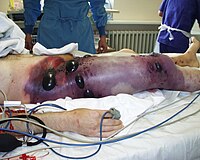
Photo from wikipedia
BACKGROUND Group A Streptococcus (GAS) skin infections can lead to invasive sepsis, poststreptococcal glomerulonephritis, and potentially rheumatic heart disease (RHD). Within a study to identify predisposing factors of RHD in… Click to show full abstract
BACKGROUND Group A Streptococcus (GAS) skin infections can lead to invasive sepsis, poststreptococcal glomerulonephritis, and potentially rheumatic heart disease (RHD). Within a study to identify predisposing factors of RHD in Ugandan schoolchildren, we determined the prevalence of skin infections and assessed the clinical features and antibiotic susceptibility of GAS skin infection. METHODS Cross-sectional study conducted at 3 urban primary schools in Western and Northern Uganda in March 2017. A dermatologist rendered clinical diagnoses and obtained a skin swab specimen from lesions with signs of bacterial infection. Beta-hemolytic colonies underwent Lancefield grouping, species identification by polymerase chain reaction and antimicrobial susceptibility testing. RESULTS From 3265 schoolchildren, we observed 32% with ≥1 fungal, 1.8% with ≥1 bacterial, 0.9% with ≥1 viral, and 0.2% with ≥1 ectoparasitic infection. Of 79, 25 (32%) specimens were GAS-positive, of which one-third demonstrated tetracycline resistance. Of 17 impetigo cases, 13 (76%) were located on the leg/foot and 3 (18%) on the head/neck. Prevalence of GAS skin infection was 0.8% (25 of 3265). In Northern Uganda, where subclinical definite RHD prevalence is 1.1%, GAS skin infection prevalence was 1.2% (4 of 343) and 0.9% (3 of 352). CONCLUSION This study identifies tetracycline-resistant GAS in Ugandan communities, suggests modified skin examination of exposed anatomic locations may be appropriate for population-based GAS skin infection studies, and underscores need for clear case definitions of GAS skin infection. Future studies are needed to evaluate the role of GAS skin infection in development of RHD in Ugandan communities.
Journal Title: Pediatric Infectious Disease Journal
Year Published: 2019
Link to full text (if available)
Share on Social Media: Sign Up to like & get
recommendations!